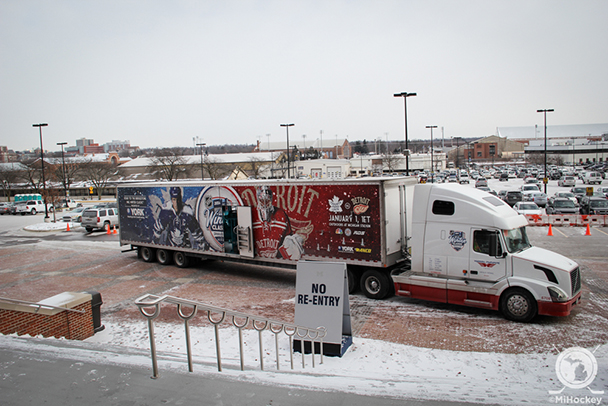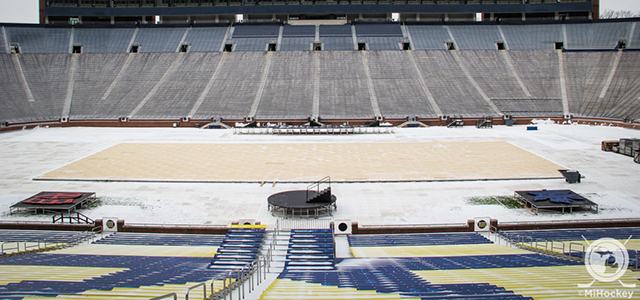Ice construction can now begin at Michigan Stadium
By Stefan Kubus –
The 2014 NHL Winter Classic ice truck showed up at The Big House Thursday afternoon after a two-day trip that began in Oakville, Ontario.
With that, measures can officially be taken to lay down the ice surface at Michigan Stadium.
Executive Vice President of Events Don Renzulli and NHL Senior Director of Facilities Operations Dan Craig were on-hand to provide updates on the construction process and ice truck’s refrigeration system.
Construction began at The Big House on Dec. 2, is scheduled to run until a Christmas break on Dec. 23 and then crews will resume working on the 26th.

“We came in on Dec. 2 and really down to the base for the ice,” Renzulli said. “Underneath the plywood is a number of pieces that make up a deck so we can get level, then the plywood goes on and Dan will take over from there, put his plates down next week, then his boards and glass and he’ll eventually start making ice.
“It’s really a planning process, it’s understanding what’s got to happen and when. We go through an extensive process with all of our vendors to lay out a schedule, but not only do that, we have our architectural firm come in and draw an extensive set of blueprints. We have everything broken down into segments of the stadium, underneath, on the field, things like that, so we know where everything is going.”
Renzulli added that the stadium needs some snow to help cover up parts of the field, but said if there’s too much, it could slightly interfere. However, that’s why he and his crew began working a month in advance.
For fans, there will be seat cushions on every seat in Michigan Stadium for fans attending the game. Additionally, there will be an auxiliary ice surface in one of the endzones for kids to skate on before the game and during intermissions.
The NHL will also create a big tailgating location, dubbed ‘Spectator Plaza’, outside Crisler Center with live music, food and beverages, open from 9 a.m. until puck drop.
“It’s fun,” Renzulli said. “Obviously, we were supposed to be here last year… We’re back, so it’s given us more time to plan. It’s probably a little more stressful this year because we’re doing a number of games, not just one, but I think everybody is up for the challenge.”
Ice truck
The main function of the 53-foot, 300-ton capacity refrigeration unit – one compressor is 165 tons and the other is 135 tons – is to remove heat from the ice surface and stabilize the temperature. It pumps as much as 3,000 gallons of glycol coolant into custom-made aluminum trays that are configured on the field of the stadium. The glycol, running through hoses from the refrigeration unit to the field, chills these trays in order to keep the ice near 22-degrees Fahrenheit.
Craig said that every truck since the first Winter Classic has been a little bit different, but this year’s is especially tweaked since the next stop it will make is in the warmer Los Angeles for the Stadium Series game between the Kings and Anaheim Ducks. But because of that, should warmer temperatures arise in Ann Arbor, there won’t be any issues with the ice.
“If we have a 60-degree day, don’t anybody worry about it; we’re going to play on,” Craig said. “That’s what this truck was made for. This truck was designed for us to go to the Southern climates. This will be the first run at it here to make sure all the computer boards and everything work the way they need to be.”
Craig, who began preparing ice at his local Jasper, Alberta rink while he was still in high school, worked with the Edmonton Oilers for 10 years before joining the NHL in 1997. He said, without hesitation, that the biggest thing he has fine-tuned over the years is his patience.
“On a [-18 Fahrenheit] day like today, everybody thinks you can just go out there and just put down water and you’re good. Well, that’s if you and I were public skating, that’d be great, but we’ve got guys making millions and millions of dollars. Their careers are on the line and I know that every single day.”
Monitoring the ice status is virtually a 24-hour duty, but what makes it easier for Craig is the monitoring system in place for the ice – it can be checked on via smartphone – so he doesn’t need to physically babysit the ice surface.
“We’ve got monitoring systems in here, on gauges that we put in the ice… I can still go for dinner and it comes onto the iPhone, Blackberry and I know what’s going on all the time.”
By the numbers
35.3 – Average temperature (in Fahrenheit) at puck drop for recent NHL outdoor games dating back to 2008
53 – Length, in feet, of the world’s largest mobile rink refrigeration unit, built specifically for outdoor games
350 – Gallons of water soluble paint used to make ice white
3,000 – Gallons of glycol coolant used to freeze the rink
20,000 – Gallons of water needed to create a two-inch ice surface
25,000 – Approximate feet of electrical cable used to power the rink, stages, audio systems, etc.
32,000 – Square feet of decking for construction of the rink
52,000 – Feet of plywood for the rink construction
107,000 – Capacity of Michigan Stadium


